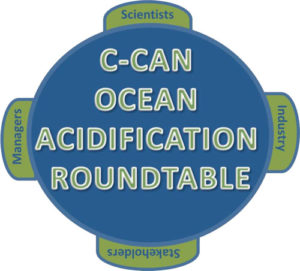
Join us for our C-CAN Roundtable discussion on Wednesday, September 18, 2019 at 1pm PT (4pm ET)
How ocean acidification works hand-in-hand with warming and other global change stressors to
promote toxic Pseudo-nitzschia harmful algal blooms along the West Coast
Presented by Dr. Dave Hutchins*, University of Southern California and hosted by Bruce Steele.
Abstract:
Toxic harmful algal blooms are an increasing problem globally, and the West Coast of the U.S. is no exception. In particular, massive neurotoxic blooms of the domoic acid-producing diatom Pseudo-nitzschia have recently appeared that are larger, more frequent, longer lasting, and much more toxic than any that have been historically recorded. In recent years, these blooms have caused extensive damage to our Dungeness crab fishery, and they pose an increasing threat to other shellfish and finfish industries. It has become clear that this unprecedented intensification of toxic domoic acid events is very likely linked to ocean environmental change. For instance, research in my laboratory has shown that ocean acidification can benefit the growth and increase the toxicity of many harmful algal bloom species, including Pseudo-nitzschia. At present day atmospheric CO2 concentrations, obtaining enough dissolved CO2 from the water to support growth can be a problem for Pseudo-nitzschia, which can thus be “carbon dioxide-limited”, and so it may actually directly benefit from higher CO2 levels. There is a definite potential for future CO2 fertilization of more frequent and more intense toxic algal blooms. However, we are now realizing that to understand and predict how ocean acidification will influence harmful algal blooms, we also need to consider a number of other interacting global change impacts. These other direct and indirect human disturbances include sea surface warming, losses of dissolved oxygen, stratification of the surface ocean, and modification of natural nutrient cycles by urban and agricultural pollution. For instance, in addition to ocean acidification, we have also shown that ocean warming strongly promotes
domoic acid production by Pseudo-nitzschia. I will discuss the complex network of interactions between ocean acidification and these many other global change multiple stressors that my lab group is currently working to understand, in order to help predict and perhaps mitigate the tremendously damaging toxic algal blooms that increasingly threaten our coastal fisheries and marine food webs.
Reserve your Webinar seat now at:
https://washington.zoom.us/meeting/register/48f3244ea206cd94d746f627e8486654
After registering you will receive a confirmation email containing information about joining the Webinar. Following the presentation there will be a few short informational announcements relevant to the C-CAN community. Please forward this invitation to interested colleagues. We look forward to seeing you at this event! More info on C-CAN and our webinar series can be found here.
Bio
Dr. Dave Hutchins is a Professor of Marine and Environmental Biology at the University of Southern California in Los Angeles. He received his Ph.D. at UC Santa Cruz, followed by a postdoc at Stony Brook, and then worked for 10 years on the faculty of the University of Delaware before moving to USC 12 years ago. Recent professional activities include election as a Fellow of the American Association for the Advancement of Science and of the Association for the Sciences of Limnology and Oceanography, and serving as Chairman of the 1st Ocean Global Change Biology Gordon Research Conference, as lead organizer of the Evolution and Climate Change in the Ocean workshop, and as Associate Editor for Marine Climate Change and Ocean Acidification at the journal Proceedings B of the Royal Society. Most of his current research examines how global change processes affect ocean biology and biogeochemistry. Particular areas of interest include how future ocean acidification, sea surface warming, and changing ocean biology, chemistry and physics will impact toxic harmful algal blooms, carbon and nutrient cycling, iron and trace metal cycling, nitrogen fixation, and phytoplankton community structure in marine ecosystems ranging from California coastal waters, to the remote polar Southern Ocean and the open ocean subtropical gyres.
Download/Print PDF Announcement: C-CANSept2019Webinar